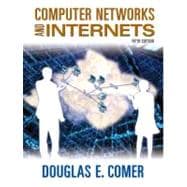
Note: Supplemental materials are not guaranteed with Rental or Used book purchases.
Purchase Benefits
Dr. Douglas Comer is an internationally recognized expert on TCP/IP protocols, computer networking, and the Internet. One of the researchers who contributed to the Internet as it was being formed in the late 1970s and 1980s, he was a member of the Internet Architecture Board, the group responsible for guiding the Internet's development. He was also chairman of the CSNET technical committee, a member of the CSNET executive committee, and chairman of DARPA's Distributed Systems Architecture Board.
Comer has consulted for industry on the design of computer networks. In addition to giving talks in US universities, each year Comer lectures to academics and networking professionals around the world. Comer's operating system, XINU, and implementation of TCP/IP protocols (both documented in his textbooks), have been used in commercial products.
Comer is a Distinguished Professor of Computer Science at Purdue University. He is currently on leave from Purdue, serving as VP of Research Collaboration at Cisco Systems. Recently, Comer has taught courses on networking, internetworking, computer architecture, and operating systems. He has developed innovative labs that provide students with the opportunity to gain hands-on experience with operating systems, networks, and protocols. In addition to writing a series of best-selling technical books that have been translated into 16 languages, he served as the North American editor of the journal Software — Practice and Experience for 20 years. Comer is a fellow of the ACM. For additional information, visit his web site.
| Preface | |
| Introduction and Internet Applications | |
| Introduction and Overview | |
| Internet Trends | |
| Internet Applications and Network Programming | |
| Traditional Internet Applications | |
| Data Communication Basics | |
| Overview Of Data Communications | |
| Information Sources and Signals | |
| Transmission Media | |
| Reliability and Channel Coding9/ Transmission Modes | |
| Modulation and Modems | |
| Multiplexing and Demultiplexing (Channelization) | |
| Access and Interconnection Technologies | |
| Packet Switching and Network Technologies | |
| Local Area Networks: Packets, Frames, and Topologies | |
| The IEEE MAC Sub-Layer | |
| Wired LAN Technology (Ethernet and 802.3) | |
| Wireless Networking Technologies | |
| LAN Extensions: Fiber Modems, Repeaters, Bridges, and Switches | |
| WAN Technologies and Dynamic Routing | |
| Networking Technologies Past and Present | |
| Internetworking | |
| Internetworking: Concepts, Architecture, and Protocols | |
| IP: Internet Addressing | |
| Datagram Forwarding | |
| Support Protocols and Technologies | |
| The Future IP (IPv6) | |
| UDP: Datagram Transport Service | |
| TCP: Reliable Transport Service | |
| Internet Routing and Routing Protocols | |
| Other Networking Concepts & Technologies | |
| Network Performance (QoS and DiffServ) | |
| Multimedia and IP Telephony (VoIP) | |
| Network Security | |
| Network Management (SNMP) | |
| Trends In Networking Technologies and Uses | |
| A Simplified Application Programming Interface | |
| Index | |
| Table of Contents provided by Publisher. All Rights Reserved. |
The New copy of this book will include any supplemental materials advertised. Please check the title of the book to determine if it should include any access cards, study guides, lab manuals, CDs, etc.
The Used, Rental and eBook copies of this book are not guaranteed to include any supplemental materials. Typically, only the book itself is included. This is true even if the title states it includes any access cards, study guides, lab manuals, CDs, etc.